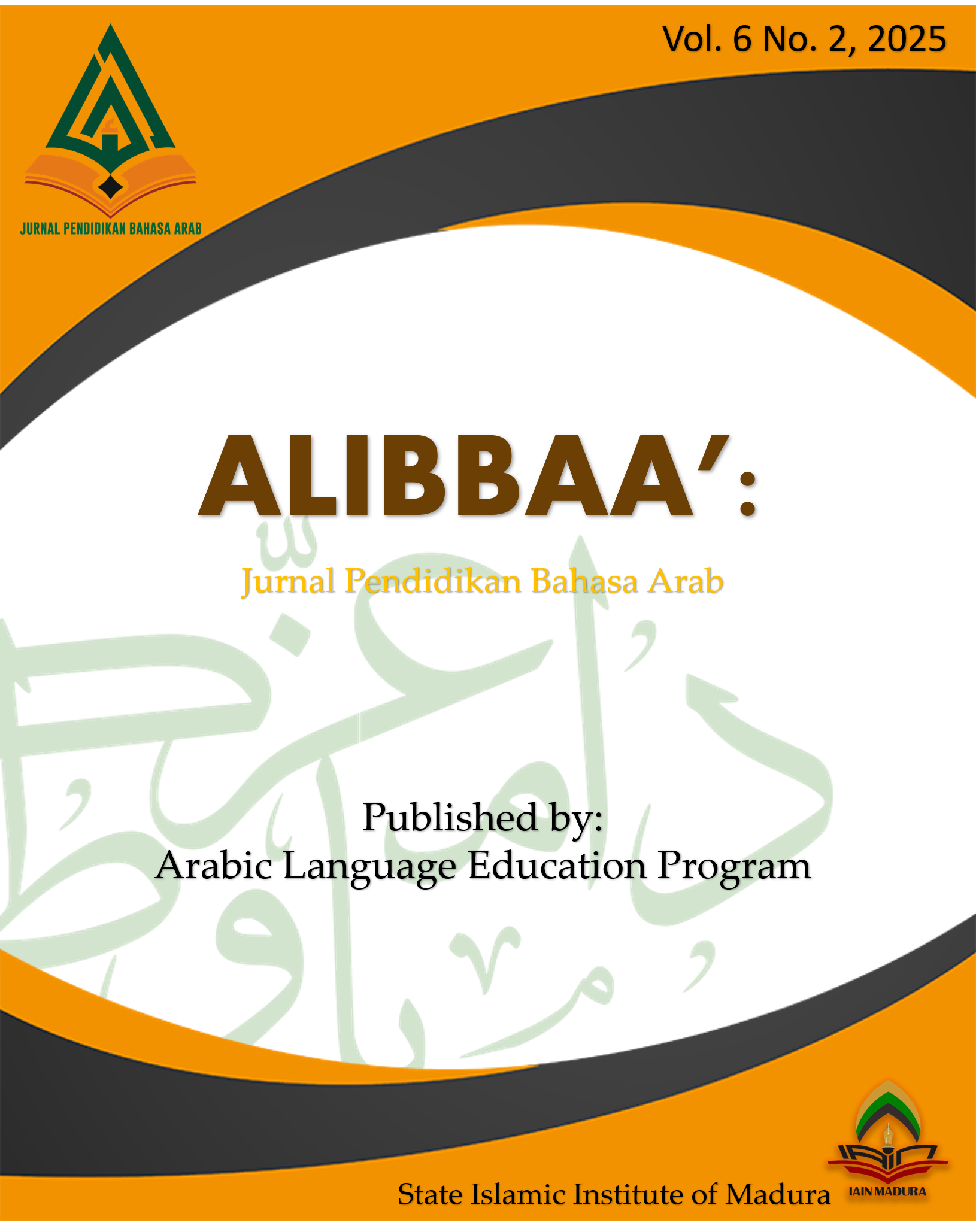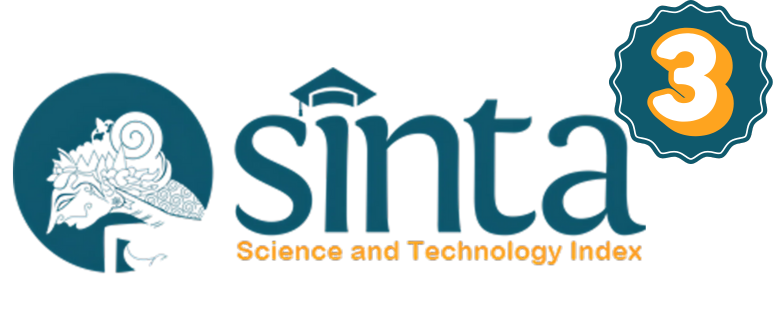Recontextualizing Arabic Reading Instruction: Developing Arabic Reading Skills Teaching Materials Grounded in Islamic Values
 Abstract views: 239
,
Abstract views: 239
,
 pdf downloads: 195
pdf downloads: 195
Abstract
This study aims to develop Maharah al-Qirā’ah (Arabic reading skills) instructional materials that integrate Islamic values and are contextualized to students’ social and proficiency levels. Utilizing a Research and Development (R&D) approach adapted from the Borg & Gall model, the research followed eight key stages, including preliminary research, planning, product development, field testing, revision, and implementation. Conducted at a single Islamic higher education institution, the study found that the developed materials significantly improved students’ reading comprehension of Arabic texts and positively influenced their affective and social engagement, including motivation and active participation. Validation by experts confirmed the materials’ feasibility, with recommendations for refining text structure and grammar. Theoretically, this research contributes to the Value-Based Content and Language Integrated Learning (VB-CLIL) paradigm by positioning Arabic reading instruction as a vehicle for values education, character building, and Islamic identity formation. The developed model is adaptable for implementation across similar Islamic educational contexts.
Downloads
References
Ainin, Moh, Mohammad Ahsanuddin, Irhamni Irhamni, Muhammad Lukman Arifianto, Moch Wahib Dariyadi, and Faishol Mahmud Adam Ibrahim. “Analyzing Errors in Lesson Plans of Arabic Teacher Professional Education Participants During the Teaching Practise at Schools.” Al-Ta’rib : Jurnal Ilmiah Program Studi Pendidikan Bahasa Arab IAIN Palangka Raya 9, no. 2 (December 2, 2021): 133–44. https://doi.org/10.23971/altarib.v9i2.3043.
Al Farisi, M.Z., H. Maulani, A.B. Hardoyo, S.M. Khalid, and N. Saleh. “Investigating Arabic Language Teaching Materials Based on Indonesian Folklore: An Ethnographic Study on the Folktale of ‘Bandung.’” Asian Education and Development Studies 13, no. 2 (2024): 134–49. https://doi.org/10.1108/AEDS-07-2023-0082.
Al-Khresheh, M.H., A. Khaerurrozikin, and A.H. Zaid. “The Efficiency of Using Pictures in Teaching Speaking Skills of Non-Native Arabic Beginner Students.” Universal Journal of Educational Research 8, no. 3 (2020): 872–78. https://doi.org/10.13189/ujer.2020.080318.
Al-Mahrooqi, Rahma, and Adrian Roscoe. Literature Teaching in the EFL Context: New Perspectives, 2012.
Almelhes, S. “Enhancing Arabic Language Acquisition: Effective Strategies for Addressing Non-Native Learners’ Challenges.” Education Sciences 14, no. 10 (2024). https://doi.org/10.3390/educsci14101116.
Almelhes, S.A., and H.E. Alsaiari. “A Conceptual Framework for Teaching Arabic as a Second Language.” Theory and Practice in Language Studies 14, no. 7 (2024): 2110–18. https://doi.org/10.17507/tpls.1407.18.
Amanda, Chikanti, and Junaid Khan. “The Influence of Internal and External Factors on Arabic Language Learning Interest among Arabic Language Education Students.” Journal of Arabic Language Learning and Teaching (JALLT) 2, no. 2 (April 16, 2024): 89–100. https://doi.org/10.23971/jallt.v2i2.178.
Barnabas, Raden Ahmad, Zainal Rafli, and Yumna Rasyid. “Cognitive and Metacognitive Strategies in Arabic Listening Learning and Relationship with Students’ Personality.” Arabiyat : Jurnal Pendidikan Bahasa Arab Dan Kebahasaaraban 6, no. 2 (December 20, 2019): 254–71. https://doi.org/10.15408/a.v6i2.11771.
Calafato, Raees, and Fei Tang. “The Status of Arabic, Superdiversity, and Language Learning Motivation among Non-Arab Expats in the Gulf.” Lingua 219 (February 1, 2019): 24–38. https://doi.org/10.1016/j.lingua.2018.11.003.
Dick, Walter, Lou Carey, and James O. Carey. The Systematic Design of Instruction. Vital Source (for Pearson) VST E+p, 2015.
Fatmawati, S. “Enhancing Students Creative Thinking Skills through Web Blog-Assisted Cooperative Integrated Reading and Composition (CIRC) Learning.” Journal of Physics: Conference Series 1157 (February 2019): 032019. https://doi.org/10.1088/1742-6596/1157/3/032019.
Ferdinan, M. Nurhidayah, and M. Pewangi. “Integration of Islamic Values in the Field of General Studies at SMP Unismuh Makassar: Evaluation of the Stake Countenance Model Approach.” Educational Process: International Journal 14 (2025). https://doi.org/10.22521/edupij.2025.14.59.
Fitriani, Laily. “Pengembangan Bahan Ajar Maharah Qiroah Berbasis Karakter Di Perguruan Tinggi.” An Nabighoh 20, no. 01 (June 24, 2018): 1–18. https://doi.org/10.32332/an-nabighoh.v20i01.1130.
Fitriyani, Nur, Rinaldi Supriadi, Kristie Agustika Putri, Yayan Nurbayan, and Kasver Mathiessen. “The Application of the Loud Reading Strategy (Al Qira’ah Al Jahriyyah) Based on Pop-Up Books in Enhancing Arabic Reading Skills.” Alibbaa’: Jurnal Pendidikan Bahasa Arab 6, no. 1 (January 10, 2025): 23–41. https://doi.org/10.19105/ajpba.v6i1.15978.
Hamidah, Hamidah, and Marsiah Marsiah. “Pembelajaran Maharah Al-Istima’ Dengan Memanfaatkan Media Youtube: Problematika Dan Solusi.” Al-Ta’rib : Jurnal Ilmiah Program Studi Pendidikan Bahasa Arab IAIN Palangka Raya 8, no. 2 (December 2, 2020): 147–60. https://doi.org/10.23971/altarib.v8i2.2282.
Harnika, Lika, Zainal Abidin, Muhammad Fikri Maulana, Serli Saputri, Afna Mufidah Salsabila, and Azron Azim. “Impact of Linguistic Environment on Speaking Skills of Female Students at the Arabic Language Center Islamic Boarding School in Indonesia.” Journal of Arabic Language Learning and Teaching (JALLT) 2, no. 2 (April 16, 2024): 121–36. https://doi.org/10.23971/jallt.v2i2.180.
Hassan, Shahir Akram, and Wan Mohd Khairul Firdaus Wan Khairuldin. “Research Design Based on Fatwa Making Process: An Exploratory Study.” International Journal of Higher Education 9, no. 6 (September 30, 2020): 241. https://doi.org/10.5430/ijhe.v9n6p241.
Huberman, Michael, and Matthew B. Miles. The Qualitative Researcher’s Companion. SAGE, 2002.
Huda, Nurul, Isnaini Maulidia Annisa, and Muhammad Nuruzzaman Syam. “Writing Skills Teaching Methods for Elementary School Students: Scramble in Connecting Arabic Letters.” Alibbaa’: Jurnal Pendidikan Bahasa Arab 5, no. 2 (August 7, 2024): 268–87. https://doi.org/10.19105/ajpba.v5i2.15084.
Ilmiani, Aulia Mustika, Hamidah Hamidah, Nurul Wahdah, and Mahfuz Rizqi Mubarak. “The Implementation of Semester Learning Plan (RPS) on MaharahIstima’ Course by Using Cartoon Story Maker.” LISANIA: Journal of Arabic Education and Literature 4, no. 1 (June 26, 2020): 1–22. https://doi.org/10.18326/lisania.v4i1.1-22.
Jamil, Husnaini, Nur Agung, and Takdir Takdir. “Penyusunan Materi Ajar Al Nahw Al Whazhifi Dan Penerapannya Dalam Pembelajaran Bahasa Arab Untuk Mahasiswa PAI IAI Muhammadiyah Sinjai.” Alibbaa’: Jurnal Pendidikan Bahasa Arab 1, no. 2 (August 25, 2020): 175–96. https://doi.org/10.19105/ajpba.v1i2.3571.
Kaefer, Tanya. “When Did You Learn It? How Background Knowledge Impacts Attention and Comprehension in Read-Aloud Activities.” Reading Research Quarterly 55, no. S1 (2020): S173–83. https://doi.org/10.1002/rrq.344.
Kung, Fan-Wei. “Teaching Second Language Reading Comprehension: The Effects of Classroom Materials and Reading Strategy Use.” Innovation in Language Learning and Teaching 13, no. 1 (January 2, 2019): 93–104. https://doi.org/10.1080/17501229.2017.1364252.
Loopoo, V., and R.J. Balfour. “Improving Reading Strategies and Assessments Used by Educators to Enhance Learner Academic Success.” Per Linguam 37, no. 1 (2021). https://doi.org/10.5785/37-1-984.
M.Ed, Prof Dr H. Punaji Setyosari. Metode Penelitian Pendidikan & Pengembangan. Prenada Media, 2016.
Mirasol, R.G. “Title: Exploring Junior High School Students’ Critical Reading Strategies and Reading Performance.” Cogent Education 11, no. 1 (2024). https://doi.org/10.1080/2331186X.2024.2416814.
Moss, B. “GETTING THE PICTURE: VISUAL DIMENSIONS OF INFORMATIONAL TEXTS.” In Handbook of Research on Teaching Literacy Through the Communicative and Visual Arts: Volume II, 2:393–98, 2015. https://doi.org/10.4324/9781315759616-53.
Muna, Zulfa Tsalitsatul, Nur Hidayah, Muhajir, Ashley Le Souef, and Alyssa Devaney. “Mind Mapping as an Innovation in Reading and Writing Learning: A Study of Understanding Arabic Texts.” Alibbaa’: Jurnal Pendidikan Bahasa Arab 6, no. 1 (January 30, 2025): 120–37. https://doi.org/10.19105/ajpba.v6i1.15963.
Nichols, J.B., P.H. Howson, B.C. Mulrey, A. Ackerman, and S.E. Gately. “Promise of Place: Using Place-Based Education Principles to Enhance Learning.” International Journal of Pedagogy and Curriculum 23, no. 2 (2016): 27–41. https://doi.org/10.18848/2327-7963/cgp/v23i02/27-41.
Putri, Septya Novena, Anak Agung Gede Agung, and I. Kadek Suartama. “E-Module with the Borg and Gall Model with a Contextual Approach to Thematic Learning.” Journal for Lesson and Learning Studies 6, no. 1 (March 11, 2023): 27–34. https://doi.org/10.23887/jlls.v6i1.57482.
Ritonga, Mahyudin. “Desain Bahan Ajar Bahasa Arab Sains Dengan Pendekatan Whole Language.” EDUKASI: Jurnal Pendidikan Islam 5, no. 2 (December 1, 2017): 1–24.
Riyadi, I., Hersulastuti, T.K. Nugrahaningsih, and I.M. Sudana. “Enhancing Comprehensive Reading Skills: Learning from Metacognitive Strategy.” International Journal of Innovation and Learning 26, no. 4 (2019): 391–406. https://doi.org/10.1504/IJIL.2019.102904.
Stein, S.J., G. Isaacs, and T. Andrews. “Incorporating Authentic Learning Experiences within a University Course.” Studies in Higher Education 29, no. 2 (2004): 239–58. https://doi.org/10.1080/0307507042000190813.
Succarie, A. “Examining the Implications of Islamic Teacher Education and Professional Learning: Towards Professional Identity Renewal in Islamic Schools.” Education Sciences 14, no. 11 (2024). https://doi.org/10.3390/educsci14111192.
Wahba, Kassem, Zeinab A. Taha, and Liz England. Handbook for Arabic Language Teaching Professionals in the 21st Century. Routledge, 2014.
Wijekumar, K.K., P. Lei, M. Rice, A. Beerwinkle, S. Zhang, and B.J.F. Meyer. “A Web-Based Intelligent Tutoring System for Reading Comprehension Delivered to Fifth-Grade Students Attending High-Poverty Schools: Results From a Replication Efficacy Study.” Journal of Educational Psychology 116, no. 8 (2024): 1333–51. https://doi.org/10.1037/edu0000878.
Zaki, M. “Corpus-Based Teaching in the Arabic Classroom: Theoretical and Practical Perspectives.” International Journal of Applied Linguistics (United Kingdom) 27, no. 2 (2017): 514–41. https://doi.org/10.1111/ijal.12159.
Zulhannan, G.C. Kesuma, U. Musyarrofah, and Y. Andriansyah. “Enhancing Communicative Arabic Teaching: Evaluating the Al-Arabiyah Baina Yadaik Model.” Journal of Educational and Social Research 15, no. 3 (2025): 318–35. https://doi.org/10.36941/jesr-2025-0100.
Authors who publish with this journal agree to the following terms:
a. Authors retain copyright and grant the journal right of first publication with the work simultaneously licensed under a Creative Commons Attribution License that allows others to share the work with an acknowledgement of the work's authorship and initial publication in this journal.
b. Authors are able to enter into separate, additional contractual arrangements for the non-exclusive distribution of the journal's published version of the work (e.g., post it to an institutional repository or publish it in a book), with an acknowledgement of its initial publication in this journal.
c. Authors are permitted and encouraged to post their work online (e.g., in institutional repositories or on their website) prior to and during the submission process, as it can lead to productive exchanges, as well as earlier and greater citation of published work (See The Effect of Open Access).
Alibbaa': Jurnal Pendidikan Bahasa Arab have CC-BY-SA or an equivalent license as the optimal license for the publication, distribution, use, and reuse of scholarly work.
In developing strategy and setting priorities, Alibbaa': Jurnal Pendidikan Bahasa Arab recognize that free access is better than priced access, libre access is better than free access, and libre under CC-BY-SA or the equivalent is better than libre under more restrictive open licenses. We should achieve what we can when we can. We should not delay achieving free in order to achieve libre, and we should not stop with free when we can achieve libre.

Alibbaa': Jurnal Pendidikan Bahasa Arab is licensed under a Creative Commons Attribution 4.0 International License
You are free to:
- Share — copy and redistribute the material in any medium or format
- Adapt — remix, transform, and build upon the material for any purpose, even commercially.
- The licensor cannot revoke these freedoms as long as you follow the license terms.











